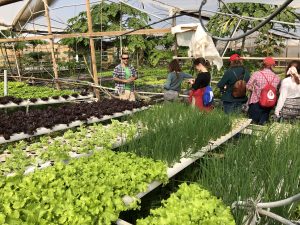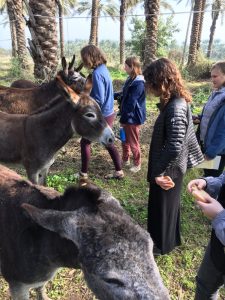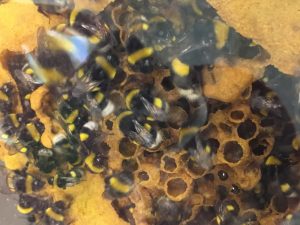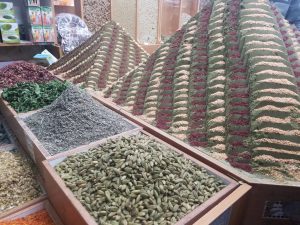It goes without saying that over the last two weeks traveling throughout Israel, we have been extremely fortunate in the weather department. While the country experienced unprecedented rainfall in the north, our group was soaking up the dry desert climate. As we moved northward, forecasts predicting overcast skies and rain yielded to sunny and warm days. Our final hours in Israel were spent exploring some of the hidden and not so hidden highlights of Haifa, a hilly coastal city located two hours north of Tel Aviv.
Our first stop was the Baháʼí Gardens located at the top of one of the city’s hills. The Haifa Baháʼí Gardens represents a spiritual and administrative site for this unique religion. Though there are no practicing Baháʼí in Israel, Haifa and more specifically, the city of Akko serve as important centers of this religion. The founding spiritual leader, the Bab foretold a new prophet the mid-19th century. Baháʼu’lláh, an exile from Iran was deemed this prophet although he spent he majority of his adult life in prison. A monotheistic religion, the Baháʼí believe in one god and believe that god is ever-present. With over seven million followers, similar to Muslims who pray in the direction of Mecca, the Baháʼí pray in the direction of Akko. The pristinely maintained gardens, including nine terraces and an equal number of fountains were landscaped with tropical flowers and semi-tropical trees culminating with a gold capped house of worship.
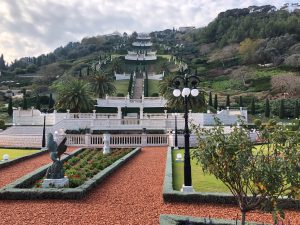
From the Baháʼí Gardens we joined Ado, a Jerusalem-born illustrator who leads food and art tours through Haifa on the side. The Beit Hagefen Gallery, with which Ado works is a Jewish-Arab Cultural Center that seeks to bring artists together in ways that help to open dialogue and understanding by honoring different religious, cultural and ethnic identities. After providing an overview of some of the gallery’s current exhibits, Ado took our group through lesser known neighborhoods with unique outdoor installations created by local artists, many of whom integrate political, cultural and social narratives in their works. One of Israel’s more ethnically mixed cities, Haifa offers artists a canvas on which to depict some of the many challenges that Israeli’s have and continue to confront.

Ado was a tremendous guide, shepherding our group through bustling thoroughfares all the while rousing our minds and stomachs with conversations on ethnically diverse foods, inter-cultural conflict and the ways in which art and food are guiding processes for dialogue. A poignant moment of our tour included Ado’s personal story as the daughter of a German holocaust survivor whose family took up residency in an abandoned Palestinian home as part of the establishment of the state of Israel. Recognizing that the dwelling that Ado calls home was once the home of a Palestinian family most likely forced out of their residence is something that Ado struggles with. Her story was quite reminiscent of Sandy Tolan’s The Lemon Tree that our class read over the course of last semester. Witnessing our guide, Ado convey her conflicted and uncensored feelings to us, and our Palestinian logistics guide, Nairoos was quite moving. Seeing two progressively minded young people navigate a tense and tremendously complicated topic was powerful to witness.

After a quick stop over at the beach to bid farewell to the Mediterranean Sea, we continued on to the airport and boarded our plane for the trip home. What a wonderful journey this has been! We are grateful to the many people who shared their homes, farms, kibbutzim, bakeries, gardens, kitchens and most importantly, their stories to us. We have learned so much and are indebted to our many hosts for their hospitality, patience and willingness to help broaden our minds and perspectives – thank you!






